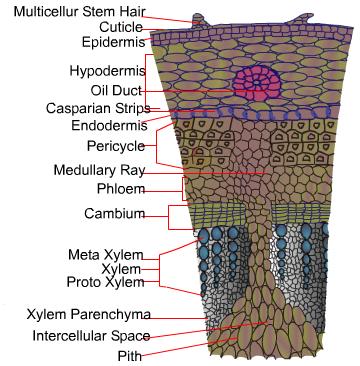Those plants whose seed contains two cotyledon or embryonic leaf is known as dicotyledon or simply dicot. In this section, you will learn about characteristics and anatomy of dicot stem.
Visit this page to learn about monocot stem.
Characteristics of Dicot Stem
Typical dicot stem show following characteristics:
- Presence of well-defined epidermis with cuticle and multicellular stem hairs.
- Cortex has collenchymatous hypodermis regularly or as discontinuous patches.
- Endodermis is distinct as the innermost layer of the cortex.
- Pericycle composed of parenchyma and sclerenchyma alternately as irregular patches (heterogenous).
- Vascular bundles are conjoint, collateral, endarch, open and arranged in a ring surrounding pith (eustele).
- The center of pith is made from thin walled parenchyma cells with distinct intercellular spaces. Pith rays or medullary rays are found as separator of two vascular bundles.
Anatomy of Dicot Stem (sunflower)
The microscopic structure of T.S. of sunflower (Helianthus annus) stem shows following distinct regions:
- Epidermis
- Cortex (hypodermis, general cortex, endodermis)
- Pericycle
- Medullary rays
- Vascular bundles
- Pith
Transverse Section (T.S.) of Dicot Stem (Sunflower)

1. Epidermis is the outermost layer of (dicot) stem with multicellular epidermal stem hairs. The cells are living, barrel shaped and compactly arranged without intercellular spaces and chloroplasts. They may contain stomata for gaseous exchange. The epidermis is externally covered by thick cuticle. The epidermal multicellular stem hairs help in protection and heat loss.
2. Cortex is present below the epidermis in several layers. It can be differentiated into:
- Hypodermis consists of 3-5 layers of collenchyma without spaces. It contains thickenings by the deposition of extra cellulose with pectin and gives mechanical support. Due to the presence of chloroplast, it also helps in photosynthesis.
- General cortex encloses intercellular spaces with resin ducts, each surrounded by a layer of small thin walled spherical or oval cells. It is made from loosely arranged parenchymatous. The cortical cells may contains chloroplast and perform photosynthesis. Some oil ducts line with epithelial cells. It also helps in gaseous exchange and storage of food materials.
- Endodermis is unilayered innermost cortex made from more or less barrel shaped compactly arranged parenchymatous tissues. It store starch and often called starch sheath. Casparian stripes are clearly visible in the endodermis region. It is the deposition of lignin and suberin. Several dicot stem may not bear distinct endodermis.
3. Pericycle, several cells in thickness, with sclerenchyma and intervening masses of parenchyma is heterogenous. They have thick wall sclerenchymatous tissue found on patches above the pholem or bast, hence also termed as hard bast or bundle cap. The hard bast helps in mechanical support and parenchyma helps in storage of food materials.
4. Medullary rays are parenchymatous, radially elongated or polygonal cells lie in between vascular bundles. It helps for the radial conduction of water and food materials. It is extension of pith, hence also called pith rays.
5. Vascular bundles are conjoint, collateral, open and arranged in a ring (eustele). Each bundle is composed of outer phloem and inner xylem on the same radius with a strip of cambium in between them (open type).
- Phloem lies outside of the vascular bundle and composed of sieve tubes, companion cells and phloem parenchyma (all are living) and few bast fibers. Companion cells are associated with sieve tubes.
- Xylem lies toward the pith or center and composed of xylem vessels, tracheids, xylem fibres (wood fibres) and xylem parenchyma (wood parenchyma). The xylem is endarch (i.e. protoxylem lie towards the pith, while metaxylem lies towards periphery). Protoxylem is smaller with annular, reticulate or spiral thickenings, while metaxylem is wider with pitted vessels. The xylem parenchyma is mostly found around the protoxylem.
- Cambium is a thin strip of two or three layered cells which are radically arranged. It lies between xylem and phloem. The cells appear almost rectangular in a transverse section and have thin wall. Due to its position, it is also called intrafascicular cambium. Cambium is a type of lateral meristematic tissues which increases the thickness of the plant through secondary growth.
6. Pith is extensively developed and occupies the central portion of the ground tissue. It is made from rounded or oval, thin walled parenchymatous cell with large amount of intercellular spaces. Pith helps in the storage of food materials.